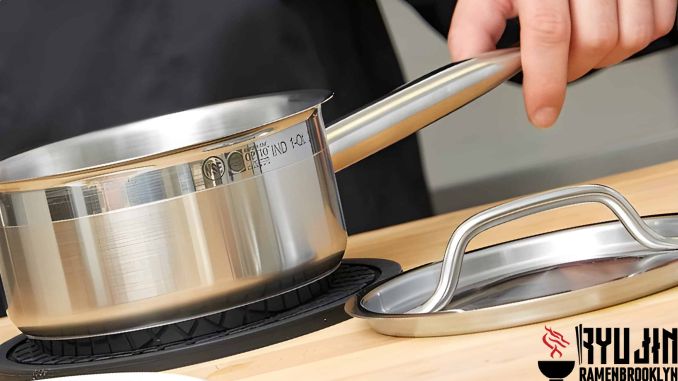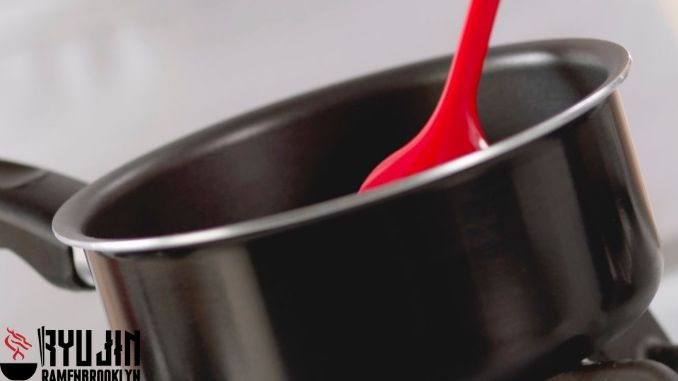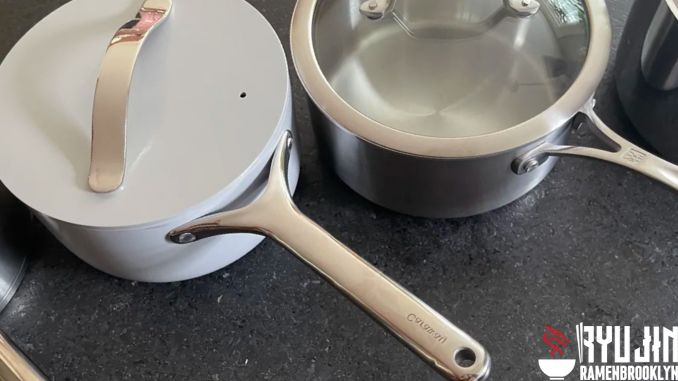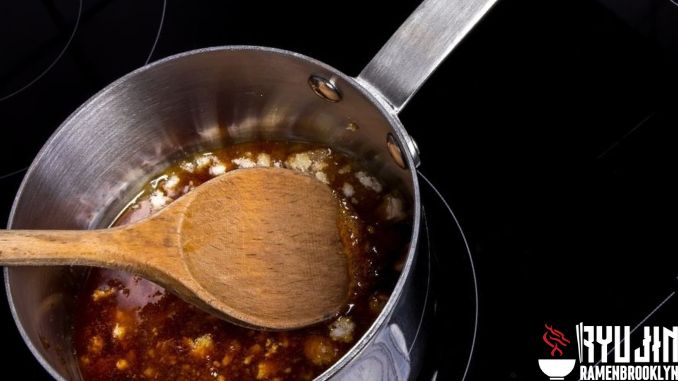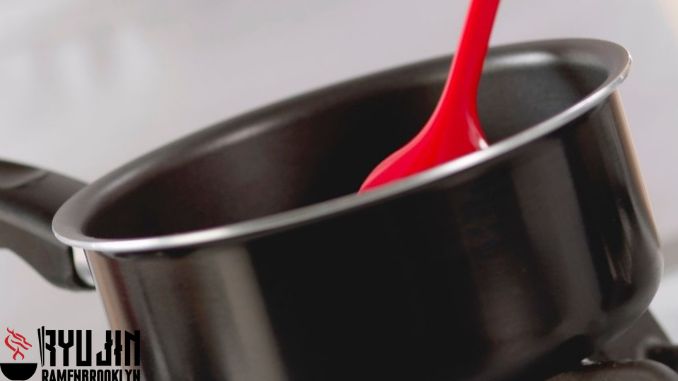What is a Saucepan?
The saucepan is a crucial pot in any kitchen. It’s versatile and generally irreplaceable: Every professional set has them, as do homes across America with busy kitchens that need all the help they can get! The famous saucier has been around for centuries–dating back to when food preparation was done by hand because there were no other options available such as gas stoves or ovens (notably).
What is a saucepan? A pan with an oven-like temperature that can be used to sauté or slow cook food. But what makes this tool so useful? Why does it have such universal appeal, even among veteran chefs who know their way around every other type of kitchen implement imaginable!
To cook food properly, you need the right cooking equipment. This includes a saucepan. But what is a saucepan, and what does it do? In this blog post, we will discuss the different types of saucepans and their uses. We will also provide tips on choosing the right saucepan for your needs. So if you are new to cooking or just need a refresher on saucepans, keep reading!
What is a Saucepan?
A saucepan is a deep, circular cooking pot with a handle attached to one side, one of the most commonly used pots in the kitchen. They come in various sizes and can be made from various materials, including stainless steel, aluminum, and copper.
Some saucepans have plastic or silicone handles to prevent burned hands, while others have phenolic resin or wood handles that can withstand high heat. The sides of a saucepan vary in height, but they are typically shorter than a stockpot. Saucepans are ideal for making sauces, cooking pasta, boiling, frying, sautéing, and simmering meats and vegetables.
The saucepan is truly one of the most versatile cooking vessels. It can be used as both a pot and pan, but its circular base makes it easier to maneuver than other types, such as steamer baskets or Japanese rice bowls, which have more curved bottoms that make them unstable on surfaces with low sinks (like kitchen desks).
Saucepans come with lids, and the most common material is stainless steel. Stainless steel is an excellent conductor that can maintain even heat distribution for perfect results every time! Plus, it’s easier to clean than other materials like cast iron or copper – which may be one reason professional chefs prefer this option over others when cooking at home (or in restaurants).
Saucepan sizes are represented by the diameter of their circular opening and are measured in either centimeters or inches. They typically range from 12 cm (4.5 inches) to 36 cm (14 inches), but the most common size is 24 cm (9.5 inches).
The circular shape makes it easy to whisk ingredients in a saucepan without spillage. Plus, the round bottom heats evenly, so there are no hot spots where food can stick or burn. The tall sides help prevent splattering and boiling over, while the large surface area allows for evaporating and reducing liquid sauces.
The Saucepan Materials
The material of choice for saucepans is metal – often aluminum with copper-coated bottoms. The purpose behind this combination? It distributes heat evenly throughout your meal while you prepare it, preventing any sticking or burning at the bottom, even if there are other types out on the market, such as stainless steel, that can also work fine! One thing worth noting: You’ll want to ensure every piece has handles made from similar materials (or all the same) so they’re easy enough to grip together when handling hot dishes later down the line.
Copper
Professional chefs recommend this for cooking because it doesn’t react with food and cleans up easily. Still, some people might not want their pans going into an oven-friendly material such as stainless steel or aluminum (which can lead to poor performance).
Copper is the best heat conductor, which means you can easily use it for cooking food. The surface of this material also has an anti-reaction coating that helps prevent reactions between your dish and minerals in foods like salts or acids used for sauces!
However, there are some downsides – because copper isn’t flexible enough, so if someone wants their pans washed by a machine, they might have difficulty getting all parts cleaned thoroughly enough without damaging anything due to the narrow gaps around sharp edges becoming clogged up.
Aluminum
This lightweight metal heats up quickly and evenly, making it ideal for cooking. It’s also non-reactive, so you don’t have to worry about unwanted reactions between your food and the pan.
Many people are likely to have aluminum pans in their kitchens, but when it comes down to durability, they’re not exactly at the top. The aluminum used in cookware is typically combined with stainless steel to make it more durable.
Though this metal has the second-lowest heat conductivity out of all others, its surface can quickly burn or dent if not protected by an outer layer that will protect against scratches and other damages during use.
Stainless Steel
This is a popular choice because it’s easy to clean and maintain. Plus, it’s less likely to scratch or dent than other materials.
This stainless steel saucepan is durable and rust-resistant. It also doesn’t conduct heat, but it works with induction cooktops! Plus, you can safely use these for broiling different meals.
Put them in the oven without worry (though I wouldn’t recommend letting water touch metal), wash by hand, or place them under a running tap to clean off residue nicely–and they’ll last forever because there’s no need replacing them every few years like we do when using copper pans due to their natural leaching material which breaks down over time.
Cast Iron
This is a heavy-duty metal that can last for years with proper care. It’s also great at retaining heat, so your food will stay hot long after you’ve taken it off the stove.
The best part about cast iron is that you can use most of these pans in the oven, but be aware some won’t work for dishwasher safety. The slow heating process and even heat distribution make them perfect on an induction range cooker or stovetop with great temperature control like gas plates do otherwise!
The downside to cast iron is that it’s one of the heaviest metals used in cookware. It’s also difficult to clean and can rust if not properly seasoned or cared for.
Cast iron is a good choice if you’re looking for a pan that can withstand years of use. Just be sure to season it regularly and don’t let it rust!
Enameled Cast Iron
This is a type of cast iron that has a coating of enamel. This makes it more durable and easier to clean than regular cast iron.
However, the enamel can chip off over time, so you must be careful with your enameled cast iron pan.
If you’re looking for a durable pan that’s easy to clean, enameled cast iron is a good choice. Just be aware that the enamel can chip over time.
Porcelain Enamel
This is a type of material that’s often used on cookware. It’s non-reactive and easy to clean. Plus, it’s more durable than other materials like aluminum or copper.
However, porcelain enamel can chip over time. So if you’re looking for a pan that will last for years, this might not be the best choice.
If you’re looking for a pan that’s easy to clean and non-reactive, porcelain enamel is a good choice. Just be aware that it can chip over time.
Saucepan Uses
Saucepans are one of the most versatile pieces of cookware in your kitchen. They can be used for various tasks such as boiling pasta, simmering sauces, frying vegetables, or even baking cakes!
One of the most popular uses for a saucepan is making soup. There are many reasons to love making soup. Whether you want a thick or thin consistency, everyone has an option! To start your delicious broth-based creation, all that is needed are some vegetables and spices along with some water or stock (depending upon what type of base ingredients). Once these have been added, carefully simmer over low heat until everything cooks through – this will take about 30 minutes but can vary depending on how big/small pieces, etc. Once cooked, remove from the stove at 850 degrees F and serve!
When it comes to pasta, there are a few different ways that saucepans can come into play. Of course, the most popular is boiling water to cook the pasta in. But what about after? Once the noodles have been cooked and strained, they can be placed back into the pot with some sauce to reheat before serving. This will help the flavors meld together perfectly! Additionally, if you’re making a baked dish such as macaroni and cheese or lasagna, the saucepan can be used to make the cheese sauce before being added to the rest of the ingredients.
Frying food is another common use for saucepans. Whether you’re cooking up some chicken strips or making french fries, this kitchen staple can help! When frying, it’s important to use a heavy-bottomed pan so that the food doesn’t stick and the heat is evenly distributed. This will help prevent burning and ensure that your food is cooked evenly.
Regarding desserts, saucepans can be used in a few different ways. One of the most popular is for making molten lava cakes. These individual chocolate cakes are made by mixing all ingredients in a pot before being spooned into ramekins and baked in the oven. Another option is using a saucepan to make a fruit compote by simmering down chopped fruit with sugar and spices until it forms a thick syrup. This can then be served over ice cream or cake for a wonderful dessert!
Blanching vegetables is another great way to use a saucepan. This involves boiling the vegetables for a short period before plunging them into ice water. This helps retain their color and nutrients while making them easier to peel.
Saucepan Tips
Now that you know how saucepans can be used, here are some tips to help you get the most out of yours!
-If you’re using a non-stick pan, use wooden or silicone utensils to prevent scratching the surface.
-To prevent food from sticking, use enough oil or butter when cooking.
-When simmering or boiling liquids, do not fill the pan more than halfway to prevent boiling over.
-If you’re making a sauce or gravy, be sure to whisk often to prevent scorching.
-When frying food, be sure to keep the heat at a consistent level to prevent burning.
-To get the most out of your desserts, use fresh fruit and high-quality chocolate.
If you’re looking to boil water or cook pasta, then you’ll want to choose a saucepan with a large diameter opening. This will give you plenty of space to add the water or pasta without overcrowding the pan. It’s also important to ensure that the pan you choose has tall sides. This will help to prevent the water from boiling over.
You’ll want to choose a saucepan with sloped sides when simmering sauces or soups. This will help to prevent the liquid from evaporating too quickly. Additionally, it’s important to ensure that the pan you choose is not too large. If the pan is too big, the sauce may take longer to reduce.
For frying foods, it’s important to choose a heavy-bottomed saucepan. This will help distribute the heat evenly and prevent the food from sticking. Additionally, you’ll want to ensure that the pan you choose is not too small. If the pan is too small, the oil will likely overflow when adding the food.
When making desserts, you’ll want to choose an oven-safe saucepan. This will allow you to make molten lava cakes or fruit compotes without transferring the mixture to another dish.
Blanching vegetables requires a saucepan with tall sides. This will help prevent the water from boiling over when adding the vegetables. Additionally, you’ll want to ensure that the pan you choose is not too small. If the pan is too small, the water may boil over when you add the ice.
How to Choose a Saucepan
The most important factor to consider when choosing a saucepan is what material it is made from. Different materials have different heat conductivity properties, meaning they will heat up at different rates and retain heat differently.
Stainless steel is a popular choice for saucepans because it is durable and has good heat conductivity. However, it is not an ideal material for cooking acidic foods like tomato sauce because it can cause the food to stick to the pan and change the flavor. Aluminum is another popular choice for saucepans because it heats up quickly and evenly. However, it is not as durable as stainless steel and can be scratched easily. Copper is an excellent conductor of heat but is also a very soft metal, so it is not as durable as stainless steel or aluminum.
When choosing a saucepan, you should also consider the size. Saucepans come in various sizes, from small 1-quart pans to large 8-quart pans. The size you choose will depend on what you plan to use the pan for. For example, if you only use the pan for boiling water or making small batches of food, a 1-quart pan will suffice. However, if you plan on cooking larger batches of food or entertaining guests, an 8-quart pan would be a better choice.
As a general rule of thumb, it’s always better to err on the side of too much rather than too little when it comes to cookware. After all, you can always find other uses for a larger pan, even if you don’t need it immediately. For example, a 3-quart saucepan can also be used as a small stockpot or Dutch oven in a pinch.
There are many other factors to consider:
-What is your budget? You can find saucepans made from various materials at different price points.
-What is your cooking style? If you are an experienced cook, you may want to choose a pan with a higher quality material that will last longer. If you are a beginner, you may want to choose a cheaper pan made from a less durable material.
-What is the size of your kitchen? If you have a small kitchen, you may want to choose a smaller pan, so it doesn’t take up too much counter space.
-Do you have any special dietary needs? If you are cooking for someone with allergies or food sensitivities, you may want to choose a pan made from a material that is less likely to cause reactions.
The Benefits of Using a Saucepan
There are many benefits to using a saucepan, including:
-They are versatile. Saucepans can be used for various tasks, from boiling water to making sauces and soups.
-They are available in a variety of sizes. This means that you can choose a pan that is the perfect size for what you need.
-They are made from a variety of materials. This means you can choose a pan best suited for your needs.
-They have many uses. Saucepans can be used for cooking, serving, and storing food.
-They are easy to clean. Most saucepans are dishwasher safe, making cleanup a breeze.
Saucepan Drawbacks
The saucepan may seem like a great cooking dish, but it has some drawbacks. One common objection from those who own this pan is that its limited volume can make preparing dinner for more than two people difficult without having to switch out dishes or use another larger pot with an additional flame source under the stovetop area where your range sits.
The shape of this cookware makes it impossible to use the hob at another time. You need constant stirring because you risk burning any food that gets stuck in corners, which will then spoil your meal completely!
The same goes for cleaning; if even one part gets missed during wiping down with a damp cloth or sponge – say right near where dust has gathered on top, then everything else becomes too contaminated for safe consumption by humans and animals alike (ingested bacteria).
With the saucepan’s long handle, transferring this heavy pan full of hot food from a table with just your hands can be difficult. Additionally, you will have trouble removing said item when not in use since there are no spires or legs on its body for stability!
The saucepan is a great choice for some people, but it might not be the best option for everyone. Consider your needs and what you will be using the pan for before making a purchase.
How to Care for and Cleaning a Saucepan
-Wash your pan after each use. This will help to prevent food from sticking and make cleanup easier.
-Soak your pan in hot water for a few minutes before cleaning. This will help to loosen any stuck-on food.
-Use mild soap and a soft sponge or cloth when cleaning your pan. Harsh scrubbers and abrasive cleansers can damage the material of your pan.
-Rinse your pan well after cleaning. Be sure to remove all soap residue, as this can cause food to stick in the future.
-Dry your pan thoroughly after washing. Moisture can cause rusting and other damage to your pan.
-Store your pan in a dry, cool place. Avoid storing your pan in a humid or damp environment, as this can cause rusting and other damage.
-If your pan becomes rusted or damaged, it is important to replace it. A damaged pan can be a safety hazard.
-If your pan becomes dirty, you may need to soak it in a vinegar and water solution overnight. This will help to remove any stubborn dirt or stains.
FAQs about Saucepan
What to Look for in a Saucepan?
You’ll want a saucepan that can take the heat without stressing out, and stainless steel is your best bet. It’s durable enough for years of use at high temperatures with little maintenance needed because it gets clean easily in between uses (just put them through their paces!). Additionally, this material makes great kitchen gadgets too!
A pan made from quality material will provide long-lasting service even when cooking acidic foods such as tomato sauces or soups. However, we recommend avoiding reactive metals like copper, which could damage dishes when washed frequently by hand-washing methods due to its reactivity behavior towards various chemicals found within the household.
Generally, tri-ply or five-ply construction is what you should look for in a saucepan. This means there are three layers of metal bonded together (usually stainless steel with an aluminum or copper core). The heat conductivity is better than what you would get from a single layer of material, and it will also distribute heat more evenly, so your food doesn’t stick or scorch as easily.
The shape of the pan also matters because sloped sides make it easier to stir without spillage while still providing plenty of surface area for evaporation. A good handle is important, too, since you’ll be lifting the pan when it’s full of hot food. Make sure it’s riveted on securely and won’t come loose with extended use!
The Different Types of Saucepans
There are three main types of saucepans: the classic, the saute pan, and the stockpot. Let’s take a closer look at each one.
The Classic Saucepan: The classic saucepan is what you typically think of when you hear the word “saucepan.” It has a deep well, tall sides, and a small diameter opening. This saucepan is ideal for making sauces, boiling pasta, simmering meat or vegetables, and frying foods.
The Saute Pan: The saute pan is similar to the classic saucepan but has shorter sides and a larger diameter opening. This pan is ideal for browning meats and vegetables, sautéing, and stir-frying.
The Stockpot: The stockpot is the largest type of saucepan and is typically used for making soups, stews, and large batches of food. This pot has tall sides and a large diameter opening.
Now that you know the different saucepans types let’s look at what to look for when purchasing one.
Would It Be Better to Buy a Cookware Set or Individual Pots and Pans?
This is a question that you’ll need to answer based on your own needs and preferences. If you’re just starting, investing in a cookware set might be a good idea. This way, you’ll have all the basics covered and can expand your collection as needed.
However, buying individual pots and pans might be the way to go if you’re an experienced cook or are looking to upgrade your current collection. You can choose what material, size, and shape you want for each piece. You can also mix and match brands to find what works best for you!
Can You Use a Pot as a Saucepan?
Yes, you can use a pot as a saucepan. However, there are some differences that you should be aware of. Pots are usually larger and have straighter sides than saucepans. This means they have more surface area, which is ideal for boiling large quantities of liquid.
On the other hand, Saucepans have sloped sides and a smaller surface area. This makes them better for simmering and reducing sauces. Additionally, the shape of a saucepan makes it easier to stir without spillage.
So, a pot is a way to go if you’re looking to boil large quantities of liquid or reduce sauces. On the other hand, if you’re looking for something to simmer soups or stews in, a saucepan is what you need.
Other Types of Cookware
When it comes to cooking, there are a few different types of cookware that you can choose from. Each has its advantages and disadvantages, so it’s important to choose the right one for your needs.
Saucepans are a type of pot that is designed for simmering and reducing sauces. They have sloped sides and a smaller surface area, making it easier to stir without spillage. Additionally, the shape of a saucepan makes it easier to control the heat and prevent scorching.
Pots are another type of cookware that can be used for boiling large quantities of liquid or reducing sauces. They usually have straighter sides than saucepans and a larger surface area. This means that they can evaporate liquid more quickly, making it more difficult to stir without spillage.
Skillets are a type of pan that is designed for frying and sautéing. They have a flat bottom and flared sides, making them ideal for browning food. Additionally, the shape of a skillet allows fat and oil to drain away from the food.
Grill pans are an essential tool in any kitchen. Not only do they help you cook food better by preventing sticking and wasting money on unnecessary ingredients or cooked items, but it is also possible to use them with solid fuels like wood chips for barbecues!
They’re made of materials that allow drainage so fat doesn’t stick within its interior – this means there will be less chance your steaks become prone to grilled cheese sandwiches too soon after purchase due solely because their surface hasn’t been cleaned.
Cast iron pans are a type of pan made from cast iron. They are durable and can be used on any cooking surface, including induction cooktops. Additionally, they evenly distribute heat and can be used to sear meat.
Now that you know the difference between a saucepan and other cookware, you can choose the right one for your needs. A saucepan is a way to go if you’re looking to simmer or reduce sauces. If you’re looking to boil large quantities of liquid or fry food, a pot or skillet might be what you need. And if you’re looking for a grill pan or cast iron pan, there are plenty of options!
What is the Difference Between a Saucepan and a Stockpot?
The difference between a saucepan and a stockpot is primarily one of function. A large pot with straight sides, the stockpot can hold more water than other types because it has ample surface area to accommodate all those liquids as they boil away – making soups or stews much easier!
In contrast, sloped-sided utensils such as this were designed specifically for reducing sauces from the pan onto the heat source without worrying about spillage, making them perfect if you want an even smoother consistency while constantly stirring over low heat.
From a size perspective, most saucepans will have a capacity of 2 quarts or less, while stockpots usually have a capacity of 4 quarts or more. So, if you’re looking to cook large quantities of soup or stew, a stockpot is what you need. A saucepan is what you want if you’re looking for something to reduce sauces in.
See more:
- The Differences and Similarities between Thermoelectric and Compressor Wine Cooler
- Whynter Wine Fridge Reviews
Conclusion
The saucepan is an excellent choice for anyone who wants to save time in their kitchen. You can use this durable, versatile pan every day, whether preheating food or cooking dinner with friends and family!
When you get the perfect saucepan for your kitchen, it will be an excellent workhorse that does all of those other pans’ jobs and allows you to make countless dishes, from appetizers to desserts.
Now that we have learned what a pan is and how common they are in kitchens across America-you can add this valuable toolset to yours too!
If you have any questions about “what is a saucepan?” or what types of cookware are right for your kitchen, please contact us! We would be happy to help you choose the perfect cookware for your needs.
Anthony Michelin (March 26, 1960) is the CEO of Ryujinramenbrooklyn.com – is an expert in finding specialized equipment to assist in the Bar & Kitchen sector. With over 40 years of focus on finding the simplest recipes on the most suitable cookware to create the most delicious meals, I believe it will help you.
